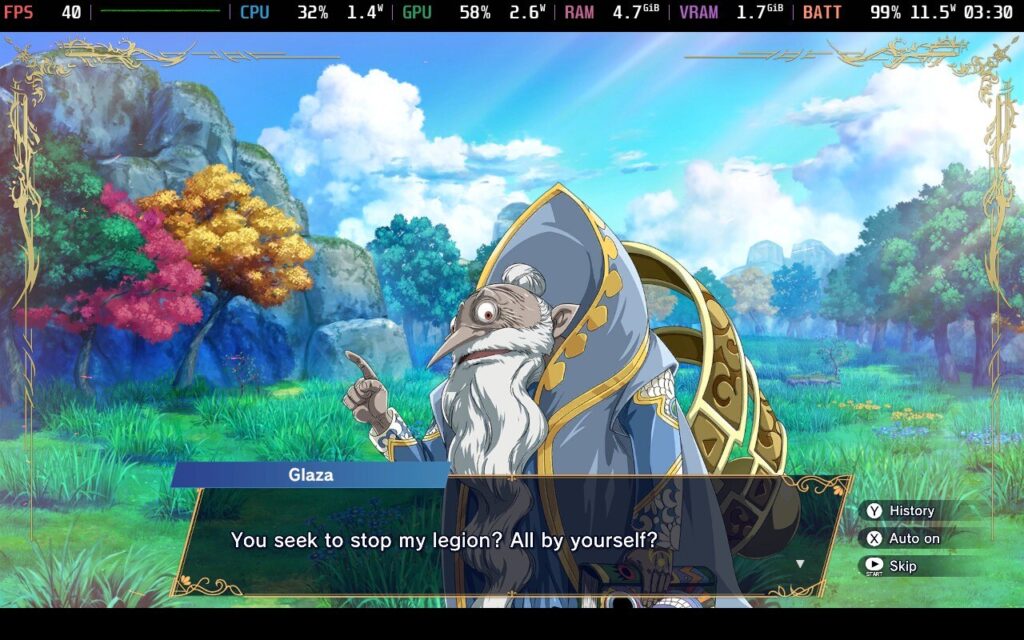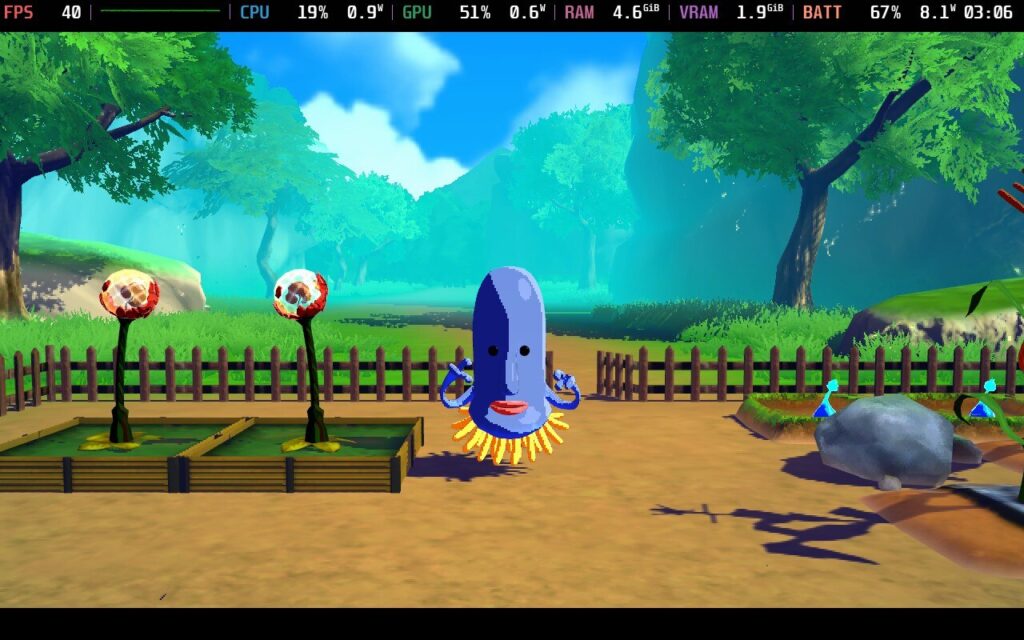7W - 9W

Farmagia was provided by XSEED Games for review. Thank you!
This review was created using an LCD Steam Deck. OLED testing will be carried out at a later date.
Farmagia was not at all what I expected it to be. This JRPG is a bizarre mix of dungeon crawling and farming, with a combat system that strongly reminds me of the Pikmin franchise. Expectations can be a double-edged sword, and while there are some interesting ideas, I struggled to get invested.
Farmagia’s fantasy world, Felicidad, is in turmoil from the evil new ruler, who has been rooting out all magic in his quest for dominance over humankind. His legions of monsters have taken over most of the country, and it is up to the player Ten to join forces with the last bastions of good to save their homeland. As stories go, it’s about as cookie-cutter JRPG as it gets.

While a few animated cut scenes are sprinkled in, most are told through static characters and backgrounds. The voice acting is pretty solid overall, but I had trouble relating with any of the characters. Ten is the typical JRPG protagonist. He is loud, brash, not afraid to get into a scrap, and has a habit of repeating information he should already know. Despite his idiotic moments, he was endearing in his passion to protect his home. Honestly, I was more emotionally invested in his pet Lookie-Loo, who did make me smile with his more humorous attitude.

The combat is where the Pikmin comparison comes from. These battlefields are small and cramped, with little room to maneuver around. While there are sometimes a couple of branching paths that hide treasure behind mini-bosses, the dungeons are mostly linear events with little eye candy.
The game has many critters to nurture and collect, and they fall between the classic trilogy of ranged combat, close combat, and support. On a small map, players must command their hordes of pets to take down enemy monsters. This involves clicking a button and target-locking on the monster you want to destroy while evading or blocking their attacks as best you can.

These open dungeons consist of several stages, with a choice between stat buffs for your monsters and item drops. These item drops usually include healing items and monster seeds that can be grown on your farm to get new monsters to battle with, as well as materials used for crafting potions and food to aid you in battle. While the dungeons come with a time limit, I never had much trouble clearing them without running down the clock, so the time limit mechanic is not too arduous. You can return to previous areas anytime you want if you need to grind materials or monsters, and there are checkpoints during dungeon rooms if you need to save and return later.

Most combat skirmishes were tolerable, but the boss fights ramped up my irritation with the combat. They usually took ages to defeat with enormous health bars and shields that must be whittled down slowly by your army of critters, all while timing blocks to deal with their attacks. Grindy boss battles with gigantic health bars will always test my patience, and I only felt relief when I finished the fight. It's a shame because the battles can look pretty cool on screen with armies of critters attacking enemies. Farmagia’s combat is more style than substance, and because it is such a big portion of the game, it dragged down my enjoyment.

Outside the combat runs, there are a few things to do. The farming segment of Farmagia is built around growing new pals to join you in battle, and there are many things to unlock, such as new tools for expanding the farm and faster harvesting. All actions on the farm take up SP, which can be replenished only by venturing into the combat areas. In the ranch, you can spend time with the pets, train up their stats, feed them treats, and watch little cut scenes that don’t add much but are wholesome moments.

The lack of overworld exploration bites hard, and there are only a few static places to visit: a pub and a magic shop. You can turn in little side jobs for the citizens for resources and buy new items, but there isn’t much else. If Felicidad had been more accessible for exploration, I would have appreciated world design more. Instead, we’re limited to small, linear dungeon romps and static scenes to pull that weight.
Despite these problems, I appreciate how far the game goes into its compendium. Every tutorial, monster, and character is lovingly set out in the codex menu with animations. It says something about Farmagia's gameplay when I find my favorite part of the codex.

I found the overall technical side of Farmagia solid across the board. I’ll go into more detail in the Steam Deck side of the review, but it played fairly well overall. The only problem I encountered was the camera during intense combat scenes, but that was during fights involving many enemies, and I had a larger squad of critters. Based on functionality, it plays well with decent enough visuals, though the gameplay did make it hard to enjoy.
While I was disappointed a bit, I cannot fault its Steam Deck performance. According to Valve, Farmagia is classified as Verified, with an Unknown rating on ProtonDB. Based on my experiences, this classification is pretty accurate!

Besides the aforementioned camera quirk, I had no problems with the default controls, and the dungeon sections ran great. Because Farmagia is more like a visual novel with its static scenes and lack of overworld exploration, only the combat sections put real pressure on the Steam Deck. It's surprisingly intensive on battery life without any modifications, but we have plenty of tools to rectify that.
I started testing at stock settings: uncapped TDP, 60hz refresh rate, and 60FPS. Even when fighting many monsters at once, the Steam Deck chews through whatever Farmagia can throw at it, even on high settings. Without any changes, however, the battery draw is intense during the dungeons, and I found it hitting 18 watts on average. While it was significantly less in the hub areas and while farming monsters (between 12 and 13 watts), this is still surprisingly heavy on the battery life, draining my LCD Steam Deck in less than 3 hours. I was initially concerned that the large amounts of text and dialogue would be rough to read, but it was perfectly understandable.

While the Steam Deck’s performance holds up well, Farmagia isn’t the kind of game that benefits from max settings, and by turning some of the graphics down with a 40hz refresh rate, I received much better battery life without sacrificing much quality. With medium settings and the 40hz refresh rate, I averaged a battery drain of just 12 watts during combat, which dropped to an average of 10 watts of power draw during other gameplay scenes. With the battery life averaging nearly 4 hours, I found this a worthy compromise while maintaining a solid 40FPS.
Because I am a sucker for battery life and enjoy squeezing as much power from my devices as possible, I played around with settings and TDP values to see what balance I could get. Farmagia is a strange case because the rest of the game requires little power apart from the combat sections. In some cases, it is almost a visual novel, but those combat sequences are frequent and very taxing on performance.

The best I could manage was a 5W TDP lock, all settings on low, and a 30FPS cap. This averaged a power draw of around 9 watts even during the combat scenes, although the frame rate occasionally dipped into the mid-20s, especially when performing power attacks. Despite this, these settings are still very playable, providing over 5 hours of battery life on the LCD Steam Deck.
Farmagia is available in English, French, German, Spanish, Japanese, Korean, Simplified Chinese, and Traditional Chinese. It has impressive accessibility features, although it lacks colorblind support.

Players can adjust the camera's y- and x-axis, the confirm button, brightness, camera speed, and where the minimap is on the screen, including turning it off completely. Three difficulty settings can be changed at any time. While the font size cannot be changed, I had no problems reading text on the Steam Deck.
To sum it up, Farmagia is a pretty mixed bag. With the repetitive and grindy combat, predictable narrative, and linear battle environments, I struggled to enjoy this one. Fortunately, it plays very well on the Steam Deck, and I did like upgrading my farm. If you can pick up Farmagia in a sale and enjoy collection games (especially when they are cute monsters!), you might get some enjoyment from this one. It is a shame I found the combat so mediocre, but that is the thing with video games. Sometimes, they just aren’t for you.
Our review is based on the PC version of this game.
If you enjoyed this article, check out the rest of the content on SteamDeckHQ! We have a wide variety of game reviews and news that will help your gaming experience. Whether you're looking for news, tips and tutorials, game settings and reviews, or just want to stay up-to-date on the latest trends, we've got you covered!
Farmagia is a monster-farming JRPG with some interesting ideas, but its repetitive and grindy combat was not appealing. It runs very well on the Steam Deck, however!
Limit
30
Refresh Rate
60
HRS
YES
TDP Limit
5
Scaling Filter
Linear
GPU Clock
Disabled
No Forced Compatibility
Low Texture Settings
Shadows Off
Bloom Off
7W - 9W
50c - 55c
~5 hours